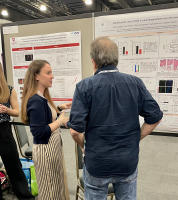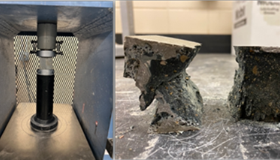
April 2025 |

Dr. Bin Su, a professor in the Department of Chemistry and a member of the Center for Gene Regulation in Health and Disease (GRHD), has been awarded a three-year, $445,500 grant from the National Institutes of Health to continue his work developing potential treatments for glioblastoma, an invasive and highly malignant brain tumor. The grant, awarded by the National Institute of Neurological Disorders and Stroke (NINDS), is titled “Enhancement of BBB Crossing of AR Degraders in GBM.”
Dr. Su’s lab has identified drug candidates that selectively inhibit the androgen receptor (AR) protein that contributes to glioblastoma progression. These small molecule drug compounds can cross the blood brain barrier (BBB), which is of critical importance to their effectiveness in treating glioblastoma. Learn More »
|
Qualtrics Data Migration Cleveland State’s Qualtrics data storage will be migrating to a US-based datacenter April 23-24, beginning at 2:00 am ET on April 23. During this time window, you may experience an error while signing in the Qualtrics platform. Any scheduled survey and email distributions will be delayed but will resume once the migration is complete. All responses to surveys will still be collected and will not be lost. |
 |
![]()
|
GRHD Doctoral Student Receives Research Conference Poster Award Samira Xhaferi, a doctoral student in Dr. Jackson Taylor's laboratory, received the Genetics Society of America Poster Award (2nd place) at the 66th Annual Drosophila Research Conference, held in San Diego, CA on March 19-25. The title of Samira’s poster was: “Exploring the role of Sirt6 in neurodegeneration and the healthy aging brain.” Dr. Taylor is an assistant professor in the Department of Biological, Geological, and Environmental Sciences (BGES) and a member of the Center for Gene Regulation in Health and Disease (GRHD). Congratulations Samira! |
 |
![]()
|
CSU Sociologists Edit and Contribute to New Book Dr. Poonam Bala, a visiting scholar in the Department of Criminology and Sociology, is the editor and a contributor for a new book, Music, Health and the Body: Cross-Cultural Perspectives. It offers new understandings of the role of music in health and its dynamic relationship with the ‘self’, identity and the human body in various socio-cultural contexts. Contributions to the book have been made by a wide range of scholars including sociologists, physicians, social historians, psychotherapists and medical practitioners, including Dr. James Chriss, a professor in the Department of Criminology and Sociology. |
 |
![]()
|
Grant Hiring Support from SPRS Are you hiring a position funded 100% by your grant or startup account? Sponsored Programs and Research Services (SPRS) will help. Click on the grant hiring link for instructions. You can also reach out to Teri Kocevar (m.kocevar@csuohio.edu) with questions. |
 |
![]()
TeCK Fund Phase 4 Award The TeCK Fund 4 is a technology commercialization and startup fund managed by Cleveland State University Research Corporation. Dr. Zhiqiang Gao, an associate professor in the Department of Electrical and Computer Engineering and Director of the Center for Advanced Control Technologies (CACT), and Ph.D. student Yu Hu applied and presented to the TeCK Fund Selection Committee on March 20th. Their application was unanimously approved for a $50,000 award. The funding will be used to validate the patent pending Generic PID platform to improve motion control tuning parameters in conjunction with Lincoln Electric. |
UPDATE: U.S. Patent Filing U.S. Provisional Patent Application 63/700,949, titled Eco-Smart and Cost-Effective Ultra-High Performance Concrete, has been filed, naming Dr. Srinivas Allena (Civil and Environmental Engineering) and Dr. Chandra Kothapalli (Chemical and Biomedical Engineering) as inventors. The invention improves ultra high-performance concrete (UHPC) by utilizing industrial wastes to substitute expensive and energy-intensive cementitious materials, significantly lowering material costs. The inventive substitute compositions include blast furnace slag, fly ash and limestone powder, thereby lowering the carbon footprint. |
![]()

|
© 2025 - Cleveland State University - Office of Research |

